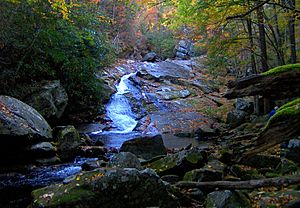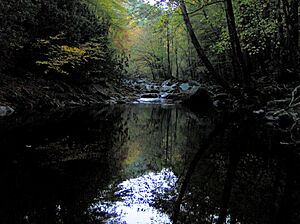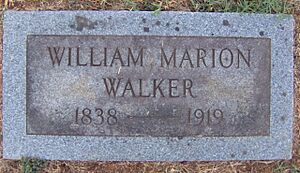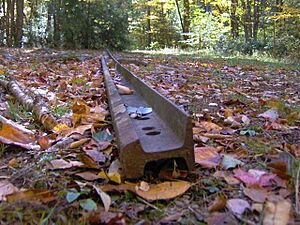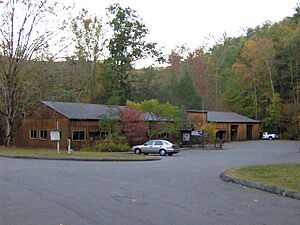Tremont, Tennessee facts for kids
Tremont is a special area located in the northwestern part of the Great Smoky Mountains National Park in the southeastern United States. It used to be a home for early settlers and a town where people worked in logging. Today, Tremont is known as the home of the Great Smoky Mountains Institute at Tremont, a place where people can learn about nature.
Contents
Where is Tremont?
Tremont is found along the Middle Prong of the Little River. It's a few miles south of a town called Townsend in Blount County, Tennessee. When people say "Tremont," they might be talking about the old logging town or the learning center there. But usually, it means the whole area around the Middle Prong river.
This area is surrounded by two ridges, Miry Ridge and Defeat Ridge. These ridges stretch out from the main peaks of the Great Smokies, which are very tall mountains to the south.
The Middle Prong river starts where two smaller streams meet: Lynn Camp Prong and Thunderhead Prong. From there, the Middle Prong flows north for about 6 miles (10 km). It joins the Little River at a spot called the Townsend Y.
About halfway along the Middle Prong, there's a flat area called Walker Valley. This valley was formed as the Middle Prong collected water from smaller streams coming down from nearby mountains. The Great Smoky Mountains Institute at Tremont is located right here in Walker Valley.
Tremont Road follows the Middle Prong river. It's paved up to the Institute in Walker Valley. After that, it becomes a gravel road for about 3 miles (5 km) until it reaches a parking area where Lynn Camp Prong and Thunderhead Prong meet. From Tremont Road, you can easily get to Cades Cove (about 7 miles or 11 km west) and Elkmont (about 13 miles or 21 km east).
Tremont's Past
Early Settlers in Walker Valley
William Marion Walker (1838–1919) was one of the first known people to live permanently along the Middle Prong. He was born nearby and moved to the area around 1859. He settled in the valley that is now named after him, Walker Valley. The Great Smokies Institute at Tremont is built on what used to be Walker's home and farm.
William Walker was a very skilled person. He was known for his amazing shooting skills. He also kept many beehives and collected honey without needing special gear. During the U.S. Civil War, he helped families in his community by cutting firewood and doing chores.
Walker was respected, but he also caused some discussion because he had more than one wife. He believed that his religious texts allowed him to do this. He had 26 children in total, though some passed away when they were babies. He let other families move into Walker Valley, and a small community grew there. Walker even built three gristmills to help the growing community grind their grain.
Logging Begins in the Area
By the late 1800s, many forests in the Eastern United States had been cut down. So, logging companies looked to the untouched forests in the Southern Appalachia mountains, like the Great Smokies. They used new tools like band saws and logging railroads to cut and move trees.
One of the first logging companies to reach Walker Valley was owned by John English from Knoxville. His company started cutting trees in a nearby area in the 1880s. English used special dams to float the logs down the Little River to a mill. One of these dams was near Walker Valley. His logging business made some money, but a flood in the late 1890s destroyed his dams, and his company closed by 1900.
The Little River Lumber Company Arrives
William Walker didn't like the idea of large logging companies cutting down the beautiful, old forests in his valley. In 1901, Colonel Wilson B. Townsend and his partners started the Little River Lumber Company. They bought a huge amount of land, about 86,000 acres (348 km²), along the Little River. But Walker refused to sell the Middle Prong area to them. This forced Townsend's company to start logging further east, in a place now known as Elkmont.
Townsend built a large sawmill in Tuckaleechee, and the town of Townsend grew up around it. He also built the Little River Railroad to connect his mill to other train lines. His engineers were very good and managed to lay railroad tracks deep into the mountains.
In 1918, William Walker became very ill. On December 26 of that year, he finally agreed to sell Middle Prong to Little River Lumber. Townsend promised him that he would not cut down trees along Thunderhead Prong. Six months later, Walker passed away. To honor him, Townsend arranged for a small train to carry Walker's coffin to the Bethel Baptist Cemetery in Tuckaleechee, where he is buried today.
The Town of Tremont
Even though Townsend sold his logging land to the Great Smoky Mountains National Park Commission in 1926, he had an agreement. He could continue logging in the area for another 15 years. After logging started in Elkmont in 1925, Townsend moved the railroad tracks to Middle Prong.
A main base for the Middle Prong logging work was set up where Lynn Camp Prong and Thunderhead Prong meet. This base quickly grew into a small town, which was named Tremont. The name came from combining "tree" and "mountain."
While Tremont was the main base, the logging camps moved further up Lynn Camp Prong as more trees were cut. These camps had small houses that could be moved on train cars. The main camp at Tremont had a post office, a hotel, repair shops, a general store, and a community building that was used as a church, school, and even a movie theater.
Dora Cope, who lived in Tremont in the late 1920s and 1930s, later shared her memories of life in the logging camps. She remembered that the camps often had rats and were at risk from fires and the unpredictable weather of the Smokies.
Townsend also tried to make Tremont a place for summer visitors. The Tremont Hotel opened in 1926 for loggers and travelers. As the logging camps moved deeper into the valley, the hotel also welcomed tourists.
Townsend had promised William Walker that Thunderhead Prong would not be cut. He kept this promise until he passed away in 1935. After Townsend's death, the Little River Lumber Company did cut down trees in Thunderhead Prong. In December 1938, the very last trees were cut in the Tremont area.
Tremont and the National Park
While logging helped the economy, cutting down so many trees in the Little River area was very bad for the river's environment. But when the Great Smoky Mountains National Park was created in 1934 and logging stopped in 1938, the forest quickly grew back.
The Civilian Conservation Corps, a group that helped with conservation work, turned the old railroad beds into roads and trails. Today, you might only see an occasional old cable or railroad tie. There's little other sign that logging ever happened there.
In 1969, Maryville College, with help from the National Park Service, started the Tremont Environmental Education Center. It was built where an old Job Corps center used to be in Walker Valley. The goal of this center was to teach people about the environment and the plants and animals of the mountains. In the early 1970s, it hosted the Youth Conservation Corps during the summer.
In 1980, the Great Smoky Mountains Natural History Association took over the education center. In 1985, its name was changed to the Great Smoky Mountains Institute at Tremont. This new name showed its strong connection to the national park. In 2014, the Institute renewed its partnership with Maryville College.


